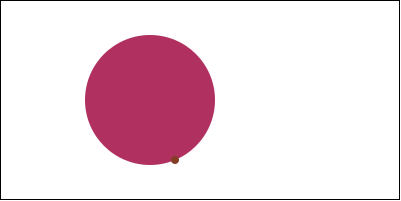7. Exercises 5
Helper functions 1
Re-use functions you have already written. This is shown a lot in the chapter (exercises 7.8-7.10, or 7.15-7.17, or 7.18-7.19). You should also be seeing it in this worksheet.
Look for ways you can use these functions later.
-
(
dot-on: image -> image): Place a radius 5 solid red circle on the lower right corner of an image. -
(
at-least-10: number -> number): Take in any number, put out a number that is at least 10.(check-expect (at-least-10 75) 75) (check-expect (at-least-10 3) 10)
Limiting values
Restricting values to an allowable range is useful all of the time. Learn to do it proficiently.
-
(
limit) Make a function calledlimitthat takes in an integer and puts out an integer between 0 and 255. Numbers below 0 should become 0, and numbers above 255 should become 255. Otherwise the answer should be the same as the input number.(check-expect (limit -8) 0) (check-expect (limit 900) 255) -
(
dot-leash): This function takes in a number (y) and puts out a radius 5 solid red circle on the lower right hand corner of a rectangle that is 2y wide and y tall.Restrictions on individual sides (these do not restrict
y, just the way the answer looks):-
the width will not grow over 300
-
the height is at most 200 and at least 10
(check-expect (dot-leash 3) (dot-on (rectangle 6 10))
-
Random numbers
-
random-tenth: number(top) -> number. Put out a random real number of the formxy.z, between 10.0 andtop. Assume the numbertopis at least 10.0.For example,
(random-tenth 10.3)could put out 10.0, 10.1, 10.2, or 10.3. Since there are four possibilities, each one should be picked about 1/4 of the time. If you run (random-tenth 10.3) a bunch of times in the bottom window, you should see all of the possibilities. -
four-up: integer -> number. Round an integer up to the nearest multiple of 4.(check-expect (four-up 9) 12) (check-expect (four-up 99) 100) (check-expect (four-up 400) 400)This question is a bit challenging. If you can the first two check-expects to pass but not the last, that’s pretty good.
Distance formula
-
The distance between (x0,y0) and (x1,y1) is
(distance x0 y0 x1 y1). Write the distance function and two good tests to make sure it works correctly. (This function is important, make sure you know how to do it without thinking too hard.)- One test should be when the answer is an integer.
- Another test should be when the answer is a square root.
-
make-circ: number(x) number(y) -> image. Produce a solid maroon circle sized so that you could place its center at (150,100) and the point (x,y) would be just on the edge.(make-circ 200 220) => (circle 130 "solid" "maroon") -
test-circ number(x) number(y) image(background) -> image. Using the given image as the background, draw a radius 4 solid brown circle centered at(x,y)and a solid maroon circle centered at(150,100)with(x,y)just on its edge.(test-circ 175 160 (empty-scene 400 200))
Animation Fun
Make a red dot follow the graph of y=x until it gets to y=150,
then move along y=150 as x increases.
Note: in the computer coordinate system, the red dot will appear to
move down and to the right as it follows y=x.